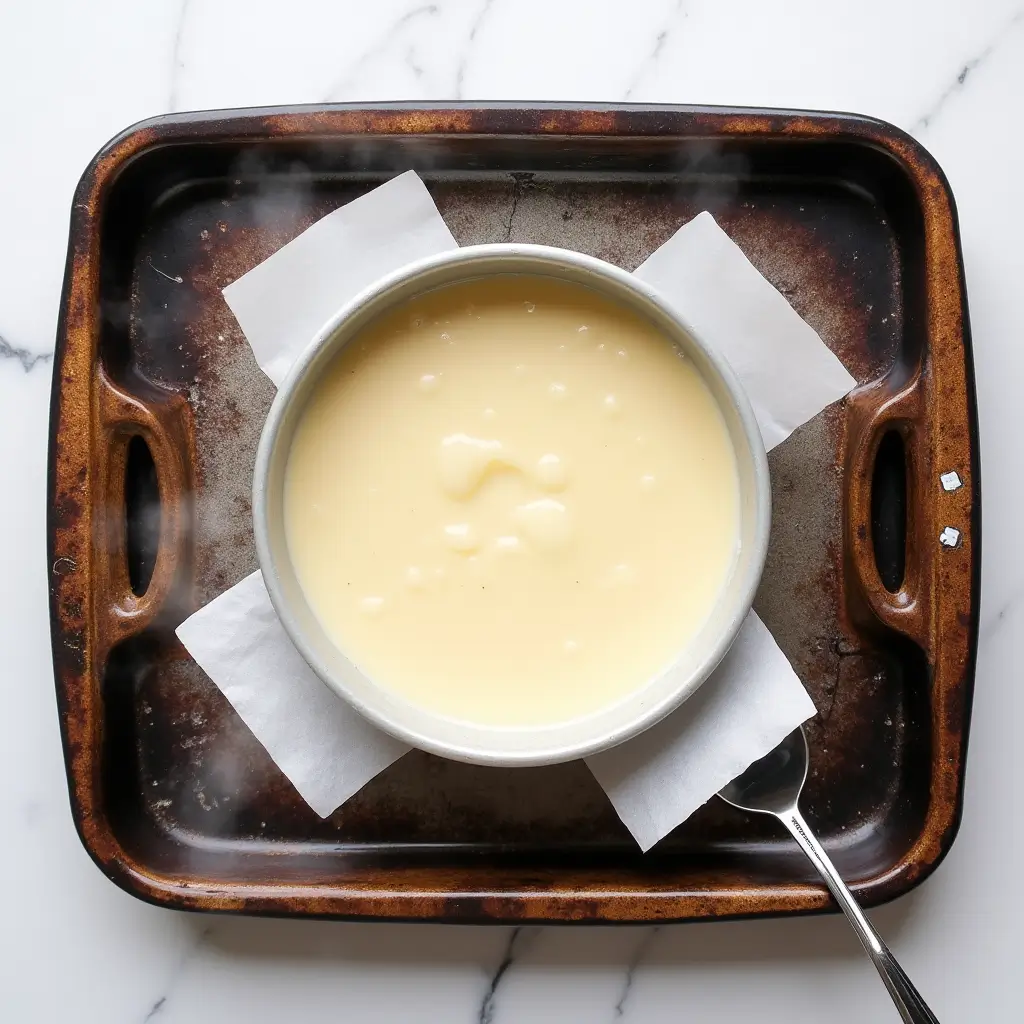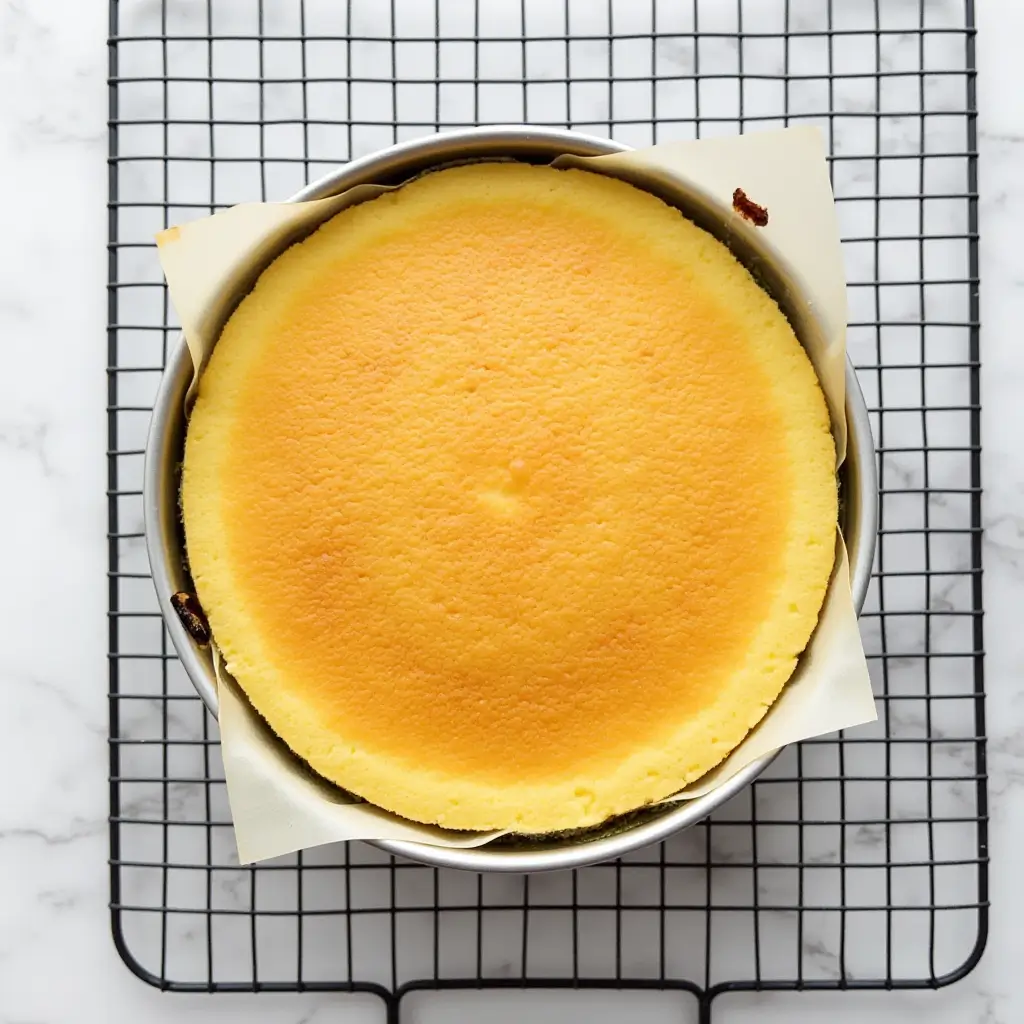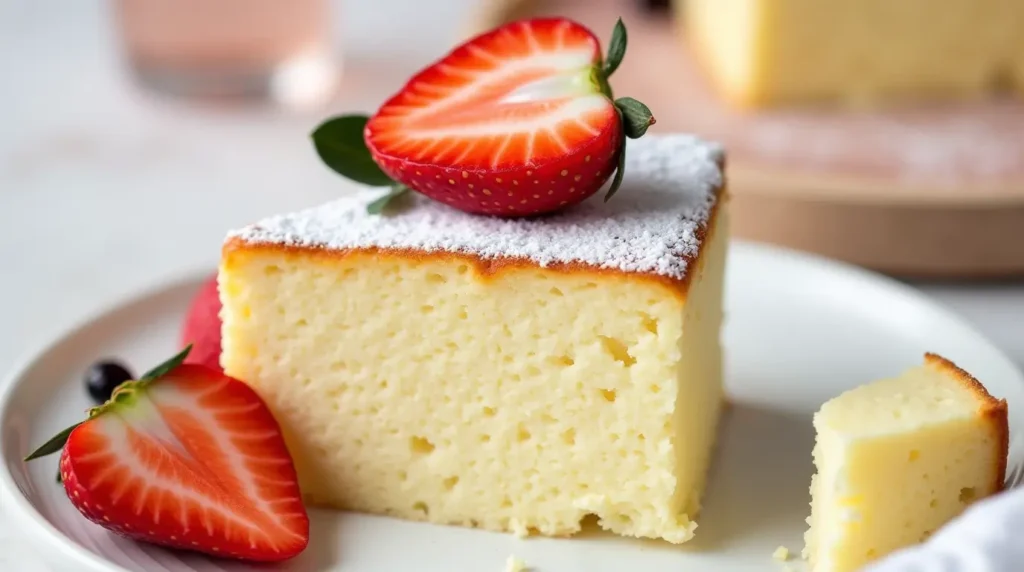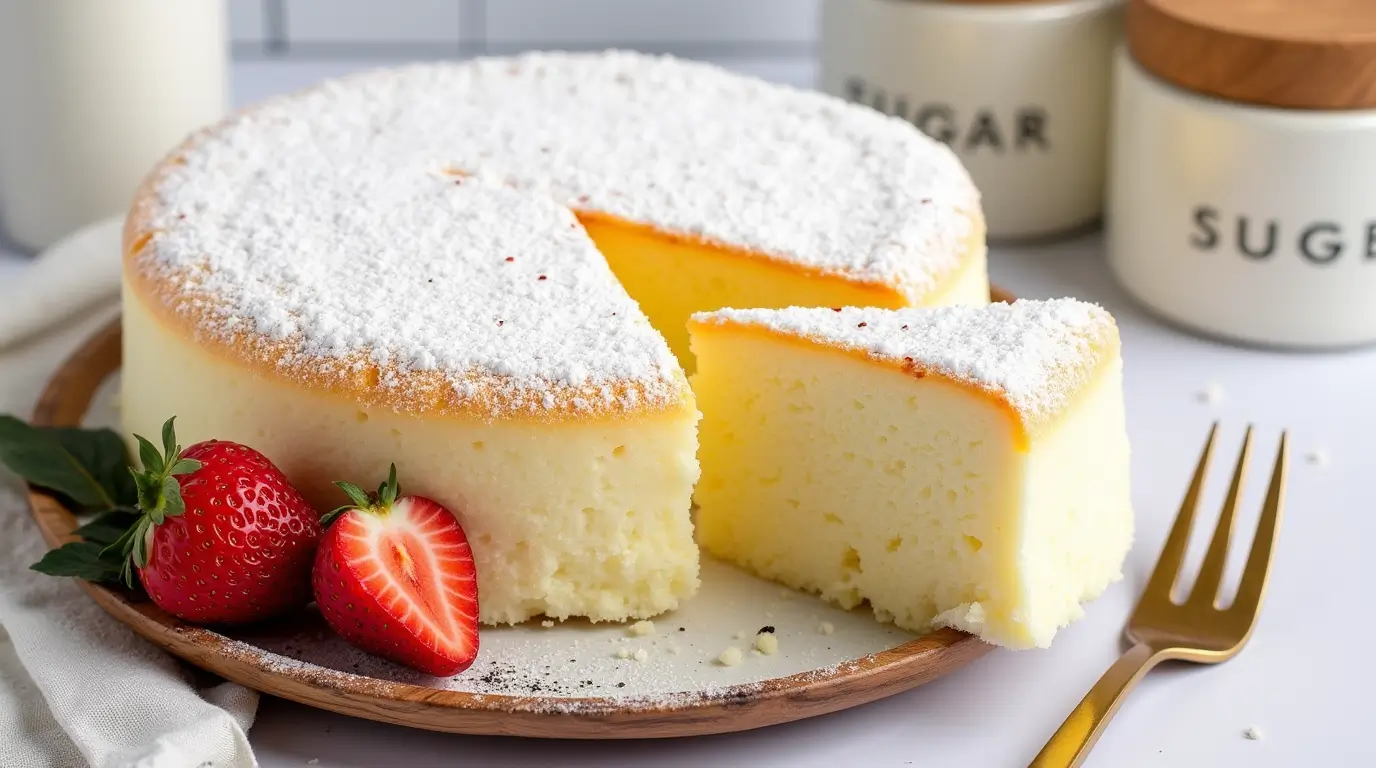Japanese Cheesecake: The Ultimate Guide to Cloud-Like Perfection
Table of Contents
Have you ever watched those mesmerizing videos of jiggly Japanese cheesecakes and wondered if you could create that magic in your own kitchen? Get ready to master the art of making this ethereal dessert that’s taken the world by storm. Unlike its dense American cousin, Japanese cheesecake (also known as cotton cheesecake or soufflé cheesecake) is a revelation of texture – impossibly light, supremely fluffy, and perfectly balanced in sweetness.
The Magic Behind Japanese Cheesecake
Born in the streets of Hakata, Japan, this extraordinary dessert was created by pastry chef Tomotaro Kuzuno in the 1960s after being inspired by German käsekuchen. He transformed the traditional cheesecake by incorporating French soufflé techniques, creating something entirely new and magical. Today, this fusion dessert has captured hearts worldwide, from Tokyo to New York, with long lines forming outside specialty bakeries just to taste this cloud-like confection.
What Makes It Special
Japanese cheesecake combines the rich creaminess of cheesecake with the light, airy texture of soufflé. The secret lies in the careful folding of meringue into a cream cheese base, resulting in a cake that literally jiggles when touched. When done right, each bite melts in your mouth, leaving you wondering if you’re eating a cloud rather than a cake.
Essential Ingredients
For the Cream Cheese Base
- 250g cream cheese, room temperature
- 60g unsalted butter, softened
- 100ml heavy cream
- 60g granulated sugar
- 6 large egg yolks
- 60g cake flour
- 20g cornstarch
- 1 tablespoon lemon juice
- Zest of 1 lemon
For the Meringue
- 6 large egg whites, cold
- 1/4 teaspoon cream of tartar
- 100g granulated sugar
For the Glaze (Optional)
- 2 tablespoons apricot jam
- 1 tablespoon water
Essential Kitchen Tools
- 9-inch (23cm) springform pan
- Parchment paper
- Stand mixer or hand mixer
- Double boiler or heatproof bowl
- Fine-mesh strainer
- Digital kitchen scale
- Candy thermometer
- Large baking pan (for water bath)
The Perfect Process
1. Preparation (30 minutes)
Start by ensuring all your ingredients are properly measured and at the right temperature. Success in Japanese cheesecake relies heavily on precision.
Pro Tip: Use a digital scale for measuring ingredients. Volume measurements aren’t accurate enough for this delicate recipe.
Pan Preparation
- Grease your springform pan thoroughly
- Line bottom and sides with parchment paper
- Create a parchment collar extending 2 inches above the pan
- Wrap outside of pan with heavy-duty foil
Pro Tip: The extended collar prevents the cake from overflowing as it rises.
2. Creating the Base (20 minutes)
- Set up your double boiler:
- Fill a pot with 2 inches of water
- Bring to a gentle simmer
- Place heatproof bowl on top (shouldn’t touch water)
- Combine cream cheese, butter, and heavy cream:
- Cut cream cheese and butter into cubes
- Melt together over double boiler
- Whisk until completely smooth
- Remove from heat when mixture reaches 40°C (104°F)
Pro Tip: Temperature control is crucial. Too hot will cook the eggs; too cool will create lumps.
- Add remaining base ingredients:
- Whisk in sugar until dissolved
- Add egg yolks one at a time
- Sift in cake flour and cornstarch
- Add lemon juice and zest
- Strain mixture through fine-mesh strainer
3. Making the Perfect Meringue (15 minutes)
This step is crucial for achieving that signature fluffy texture.
- Start with cold egg whites:
- Place in clean, grease-free bowl
- Add cream of tartar
- Begin beating on medium speed
- Create stable peaks:
- Gradually add sugar while beating
- Increase speed to medium-high
- Beat until firm peaks form (about 5-7 minutes)
Pro Tip: Test your meringue by inverting the bowl – it shouldn’t slide around.
4. The Crucial Fold (10 minutes)
This is where many bakers falter. Proper folding technique preserves the air bubbles that create the cake’s signature texture.
- Lighten the base:
- Add 1/3 of meringue to cream cheese base
- Whisk gently until just combined
- Add remaining meringue:
- Fold in two more additions
- Use large, gentle strokes
- Stop when no white streaks remain
Pro Tip: Count your folds – aim for no more than 30 total to avoid deflating.
5. Baking Process (85 minutes)
- Prepare water bath:
- Place large baking pan in preheated oven
- Pour in hot water to 1-inch depth
- Bake the cake:
- Pour batter into prepared pan
- Tap pan gently to remove air bubbles
- Place in water bath
- Bake at 320°F (160°C) for 70-75 minutes
- Reduce to 300°F (150°C) for final 10 minutes
Pro Tip: Never open the oven door during the first hour of baking.
6. The Cooling Phase (6-8 hours)
Proper cooling is as important as proper baking:
- Initial cooling (15-20 minutes):
- Turn off oven
- Crack door open with wooden spoon
- Let cake cool gradually
- Room temperature rest (1-2 hours):
- Remove from oven
- Run knife around edge
- Let cool completely
- Final chill (4-6 hours):
- Refrigerate until completely set
- Preferably overnight


Troubleshooting Common Issues
Cake Collapsed
- Meringue wasn’t stiff enough
- Oven door opened too soon
- Cooling too quick
Cake Cracked
- Oven temperature too high
- Water bath too shallow
- Pan edges not properly greased
Dense Texture
- Overfolded batter
- Ingredients not room temperature
- Incorrect measurements
Storage and Serving
- Store in refrigerator up to 5 days
- Serve slightly chilled
- Cut with warm, clean knife
- Garnish with fresh fruit or whipped cream
Nutritional Information (Per Slice)
- Calories: 250
- Fat: 18g
- Carbohydrates: 20g
- Protein: 5g
- Sugar: 15g
- Fiber: 0g
Final Tips for Success
- Patience is key – never rush the process
- Invest in quality ingredients
- Room temperature ingredients are non-negotiable
- Follow measurements exactly
- Master the meringue technique

Japanese Cheesecake: Frequently Asked Questions
Basic Questions
Q: What makes Japanese cheesecake different from regular cheesecake?
A: Japanese cheesecake is lighter and fluffier than traditional cheesecake, thanks to the incorporation of whipped egg whites (meringue). It has a soufflé-like texture and is less sweet than American-style cheesecake.
Q: Why does my Japanese cheesecake deflate after baking?
A: Deflation can occur due to several reasons:
- Underbeaten or overbeaten egg whites
- Opening the oven door during baking
- Cooling the cake too quickly
- Not using the proper water bath technique
Q: Can I make this cheesecake without a water bath?
A: The water bath is crucial for achieving the proper texture and preventing cracks. It’s not recommended to skip this step as it provides the gentle, even heat needed for proper rising and cooking.
Ingredient Questions
Q: Can I use low-fat cream cheese?
A: Full-fat cream cheese is recommended for the best texture and flavor. Low-fat versions contain more water and can affect the cake’s structure.
Q: What can I substitute for cake flour?
A: Make your own cake flour by combining:
- 1 cup all-purpose flour minus 2 tablespoons
- 2 tablespoons cornstarch
Sift together several times to combine well.
Q: Can I reduce the sugar amount?
A: Sugar affects both sweetness and structure. You can reduce it by about 25% maximum, but reducing more may affect the cake’s texture and stability.
Technique Questions
Q: How do I know when my meringue is ready?
A: The meringue should:
- Form firm peaks when the beater is lifted
- Look glossy and smooth
- Hold its shape when the bowl is inverted
- Not slide when the bowl is tilted
Q: Why did my cheesecake crack?
A: Common causes of cracking include:
- Oven temperature too high
- Insufficient water in the water bath
- Opening the oven door during baking
- Cooling too quickly
Q: How can I prevent my cake from sticking to the pan?
A: Always:
- Line the pan with parchment paper
- Grease both the pan and the parchment paper
- Let the cake cool before attempting to remove it
- Run a knife around the edge before releasing the springform
Timing and Storage
Q: Can I make this cheesecake ahead of time?
A: Yes! In fact, it often tastes better the next day. You can make it up to 3 days in advance and store it in the refrigerator.
Q: How long does Japanese cheesecake stay fresh?
A: When properly stored in the refrigerator:
- 3-4 days for best quality
- Up to 5 days maximum
- Can be frozen for up to 1 month
Q: Can I freeze Japanese cheesecake?
A: Yes, but the texture may change slightly:
- Wrap individual slices or the whole cake well
- Freeze for up to 1 month
- Thaw overnight in the refrigerator
Troubleshooting
Q: Why is my cheesecake dense instead of fluffy?
A: Common causes include:
- Overfolding the meringue into the batter
- Ingredients not at room temperature
- Incorrect measurements
- Meringue not beaten to proper consistency
Q: Why does my cheesecake have a lumpy texture?
A: Lumps usually occur when:
- Cream cheese isn’t fully softened
- Ingredients aren’t at room temperature
- Batter isn’t properly strained
- Ingredients aren’t thoroughly mixed
Q: Why didn’t my cheesecake rise properly?
A: Poor rising can be due to:
- Underbeaten egg whites
- Deflated batter from overmixing
- Oven temperature too low
- Opening the oven door during baking
Equipment Questions
Q: What size pan should I use?
A: A 9-inch (23cm) springform pan is ideal. Using a different size will affect baking time and the cake’s height.
Q: Can I use a regular cake pan instead of a springform?
A: While possible, a springform pan is strongly recommended as it makes removing the cake much easier and reduces the risk of damage.
Q: Do I really need a stand mixer?
A: While a stand mixer is ideal, you can use a hand mixer. The key is achieving properly beaten egg whites, regardless of the tool used.
Serving Questions
Q: What’s the best way to slice Japanese cheesecake?
A: For clean cuts:
- Use a sharp knife dipped in hot water
- Wipe the blade clean between cuts
- Cut with a gentle sawing motion
- Clean the knife after each slice
Q: How should I serve Japanese cheesecake?
A: Serve slightly chilled with optional toppings like:
- Fresh fruit
- Whipped cream
- Powdered sugar
- Fruit compote
- Caramel sauce
Q: Can I add toppings before serving?
A: Add toppings just before serving to prevent the cake from becoming soggy. The exception is the traditional apricot glaze, which can be applied after baking.
Making Japanese cheesecake requires attention to detail, but the results are worth every careful step. Once you’ve mastered this basic recipe, explore variations like matcha, chocolate, or sakura flavors. Share your creations with us in the comments below, and don’t forget to tag your photos with #CloudCheesecake!
Happy baking! 🍰
Tried This Recipe? Leave Your Review!
There are no reviews yet. Be the first one to write one.

